Introduction
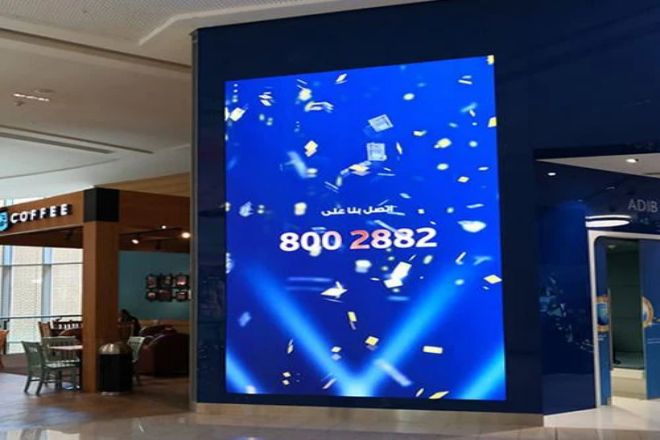
The corporate showroom, as a bridge for communication between the company and the outside world, carries multiple missions such as brand promotion, product display, and cultural exchange.
A uniquely designed and fully functional showroom can not only attract customers’ attention and enhance the company’s visibility but also effectively convey corporate culture and deepen customers’ recognition and trust in the company.
LED display screens have become an important tool for enterprises to display their image and promote products and services. It can not only provide the best display platform for products but also enable customers to understand the characteristics and advantages of products more intuitively.
1. Advantages of LED display screens in corporate showrooms
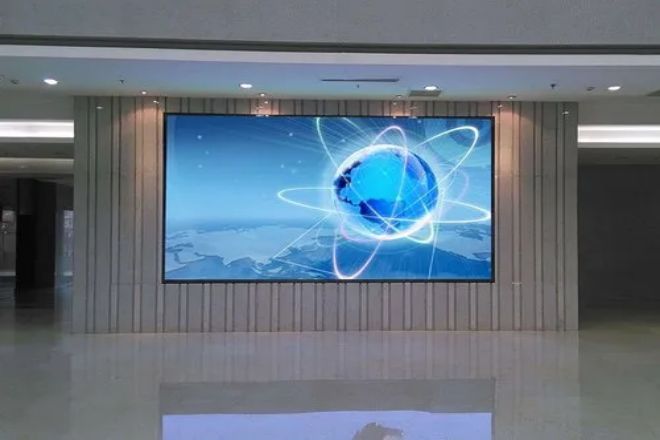
- Advantage 1: No matter where it is, information can be displayed clearly and attract people’s attention.
The LED display screen is like an oversized high-definition TV screen, but it is brighter and more colorful than a TV screen. You can imagine that we are looking at a billboard outdoors on a sunny day.
If the billboard is not bright enough, we may not be able to see the words or pictures clearly. However, if it is a billboard made of LED display, it can display the content clearly even in the sun, just like a big glowing magnet, which can attract the attention of passers-by at once.
- Advantage 2: Able to comprehensively display all aspects of the enterprise.
The LED display screen not only displays text and pictures, but it can also play videos, just like the big screen in a movie theater. In this way, companies can use it to showcase their products, services, and even the company’s culture and philosophy.
For example, a restaurant might use LED displays to show the making of their most popular dishes, or a technology company might showcase their latest technology products. In this way, the audience can have a comprehensive understanding of the company, thereby increasing their awareness and favorability of the company.
- Advantage 3: Ability to interact with the audience and improve audience participation and experience.
The LED display also has interactive functions. You can imagine that in a shopping mall, there is an LED display that can recognize your gestures or voice. You only need to wave your hand at the screen or speak your needs, and the screen will respond and display the information you are interested in.
This interactive experience will make the audience feel more interested, more engaged, and more likely to remember the company and its products.
- Advantage 4: The display content can be updated in real-time, allowing the audience to always understand the company’s latest situation.
The LED display screen also has a very practical function, which is that it can update the display content in real-time. For example, a restaurant’s LED display can display menu updates, specials, and other information in real time, or a retail store can display the latest promotions.
In this way, viewers can get the latest information every time they see the screen and will not miss any important developments.
2. Specific applications of LED display screens in corporate showrooms
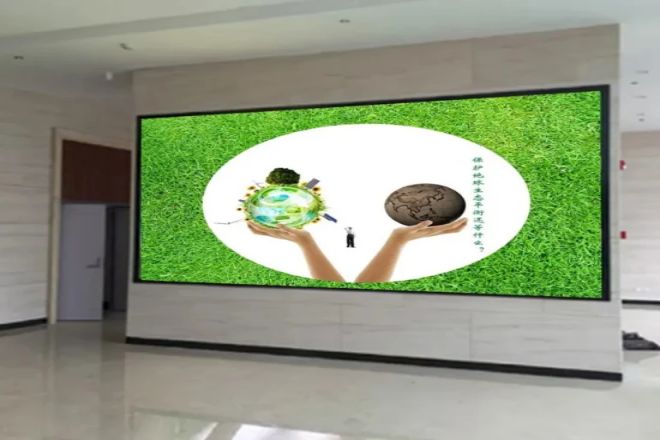
LED displays have a variety of specific applications in corporate showrooms and can be selected according to the actual needs and layout of the showroom.
- Wall installation:
An LED display screen can be installed on the wall of the showroom. The advantage of this is that when the audience enters the showroom, they will first notice the display on the wall, thus attracting their attention.
In addition, the wall-mounted display screen can display the company’s promotional videos, product introductions, and other content to provide the audience with comprehensive corporate information.
- Ceiling installation:
Some showrooms will choose to install LED displays on the ceiling. This installation method allows the display to float in the air, giving it a modern and technological feel.
At the same time, the display screen installed on the ceiling can display some important information, such as corporate slogans, product pictures, etc., so that the audience can view it at any time while walking around the showroom.
- Booth installation:
LED displays can also be installed on the booth in the showroom. This can combine the product and the display screen, allowing the audience to understand the product while getting more detailed information about the product through the display screen.
In addition, the display screen installed in the booth can also display product demonstration videos to help the audience better understand the functions and features of the product.
Why were these locations chosen? First of all, these locations are the common focus of attention for viewers in the showroom, ensuring that viewers can clearly see the content on the display. Secondly, the installation methods of these locations can be flexibly adjusted according to the actual conditions of the showroom to meet different display needs.
Finally, the application of LED displays in these locations can better integrate with the overall design style of the showroom and improve the display effect.
3. What should we pay attention to when designing and laying out LED display screens in corporate showrooms?
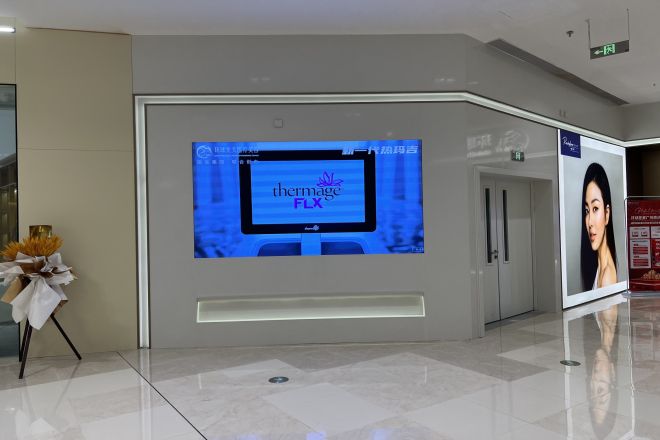
When we design and layout LED displays in corporate showrooms, there are several key factors that we need to consider carefully.
1). Clear purpose:
We must first understand the role of LED displays in the showroom.
Is it to showcase the company’s latest products to the audience?
Is it to convey the company’s culture and philosophy?
Is it to enhance the audience’s interactive experience?
After clarifying the purpose, we can choose appropriate content and design style according to this purpose.
2). Choose the right location:
The choice of location is very important as it determines whether viewers can easily notice the display. Generally speaking, the display screen should be placed in a conspicuous location of the showroom, such as the entrance, central hall, or important display area. At the same time, we also need to consider the audience’s eye height and viewing angle.
If the display is placed too high or too low, viewers may experience discomfort or be unable to see the content clearly. Therefore, we need to ensure that the display is at the right height and angle so that viewers can view it comfortably.
3). Coordinate with content:
The content of the LED display should be coordinated with the overall style and theme of the showroom. If the design of the showroom is modern and minimalist, then the content on the display should also be concise and clear, avoiding overly complex or fancy designs.
In addition, we also need to ensure that the text, pictures, videos, and other content on the display are clear and easy to understand so that viewers can quickly obtain information.
4). Consider space layout:
When laying out the LED display screen, we need to consider the overall spatial layout of the showroom. The size and number of displays should match the area of the showroom and the flow of visitors. If the showroom area is large, we can consider using multiple displays to cover different areas so that viewers can see the content at any location.
At the same time, we also need to ensure that the distance and angle between the displays are reasonable to avoid visual discomfort when the audience moves.
5). Focus on interactive experience:
If conditions permit, we can add some interactive elements to the LED display, such as touch screen, voice recognition, etc. This allows the audience to participate more actively in the display and improve their participation and experience.
For example, viewers can use the touch screen to query product information, watch demonstration videos, etc., which will make the display more vivid and interesting.
6). Consider light and illumination:
The brightness and color of LED displays are crucial to the audience’s viewing experience. We need to ensure that the display delivers clear, vivid images in all lighting conditions. If the light in the showroom is dark, we can appropriately increase the brightness of the display; if the light is bright, we can choose a high-contrast display mode to ensure the readability of the content.
In addition, parameters such as the color temperature and color saturation of the displays are considered to ensure that they harmonize with the overall lighting environment of the showroom.
7). Regular maintenance and updates:
In order to ensure normal operation and extend the service life of the LED display, we need to perform regular maintenance and updates. This includes cleaning the display surface, checking wiring connections, updating display content, etc.
Through regular maintenance, we can ensure that the display is always in good working order and provides the best viewing experience for viewers.
4. The future development trend of LED display screens in corporate showrooms
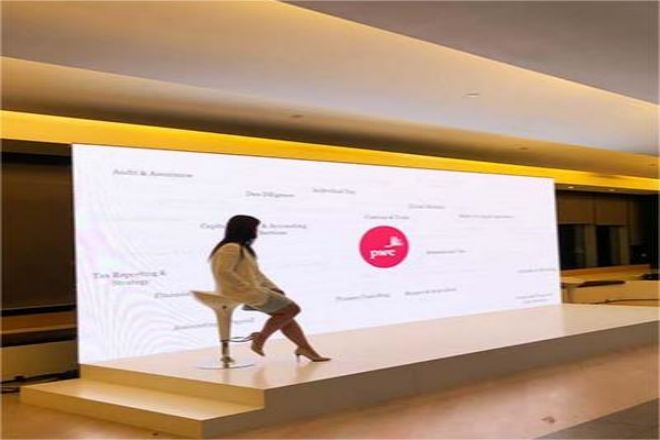
Higher energy efficiency and environmental protection: With the increasing awareness of environmental protection, LED displays will pay more attention to energy efficiency and environmental protection.
Future LED displays may adopt more advanced energy-saving technologies, such as dynamic energy saving, intelligent dimming, etc., to reduce energy consumption and carbon emissions. At the same time, LED materials will also pay more attention to recyclability and environmental protection to reduce the impact on the environment.
- Higher resolution and image quality:
With the continuous advancement of display technology, future LED displays will have higher resolution and better image quality. This will enable the display to present clearer and more detailed images to meet people’s increasing demands for visual experience.
- Larger screen size and more flexible splicing methods:
Future LED displays may have larger screen sizes and more flexible splicing methods to adapt to display spaces of different sizes and shapes. For example, multiple displays can be combined into one extra-large screen through seamless splicing technology to provide a more stunning visual effect.
- Intelligentization and Internalization:
Future LED displays will pay more attention to intelligence and Internetization. By integrating technologies such as sensors, artificial intelligence, and cloud computing, LED displays can realize functions such as intelligent control, remote monitoring, and data sharing, providing users with a more convenient and intelligent experience.
At the same time, LED displays can also be interconnected with other smart devices to realize applications in smart homes, smart offices, and other scenarios.
- Interactivity and the application of virtual reality technology:
With the continuous development of virtual reality (VR) and augmented reality (AR) technology, future LED displays will pay more attention to interactivity and the application of virtual reality technology. Audiences can interact with the display screen through gesture recognition, voice recognition, and other methods to obtain a more immersive experience.
At the same time, the LED display screen can also be used as a display interface for virtual reality equipment, bringing more realistic virtual scenes to the audience.
Conclusion
The above is the entire content of this article. Do you have a certain understanding of LED displays in corporate showrooms?
If you want to know more about LED displays, please get in touch with us!
